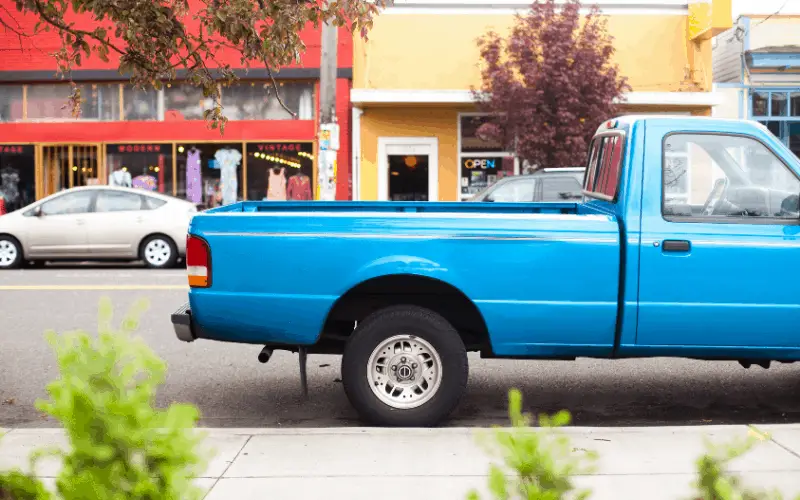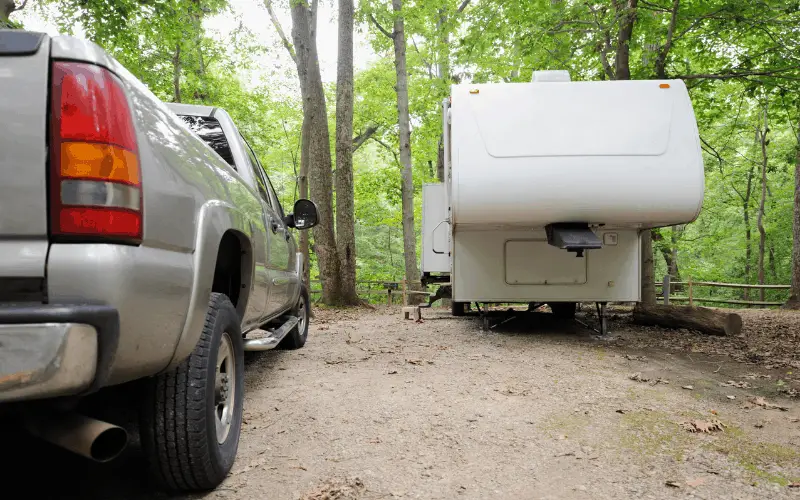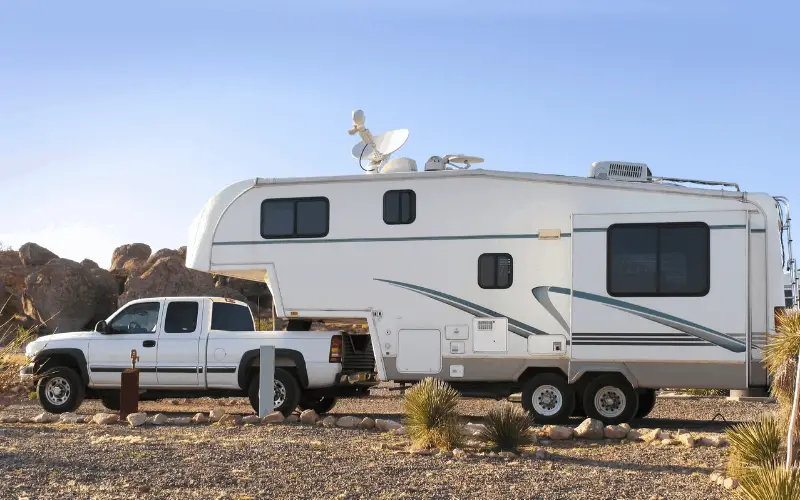Published Date: December 29, 2020
Last Updated on June 22, 2023 by Camper Front
Although towing a fifth-wheel trailer using a long-bed truck helps to increase the turning radius, using a short-bed truck tends to be more aesthetically pleasing.
In fact, most fifth-wheel manufacturers tend to design the front caps on most campers so that the owners of short-bed trucks are provided with a better turning radius.
But the real question is can you put a 5th wheel on a short-bed truck? Well, YES! You can put the 5th wheel on a short bed truth, but it comes with some challenges, which we’ll talk about shortly.
Aside from answering this question, we will also show you how to hitch your fifth wheel to a short-bed truck.
Let’s get started!
Table of Contents
Can You Put a 5th Wheel On A Short Bed Truck?
Yes! you can put the 5th wheel on a short bed truck, but there are some obstacles to overcome, this includes the trailer’s overall and hitch weight, maneuverability, and cargo space.
We shall be looking into these things in detail below. But first, what is a short bed?
What Is A Short Bed?

A short bed is used to refer to full-size pickup trucks that are equipped with a bed, measuring about 5 and a half feet long. This length varies according to the manufacturer.
Short-bed trucks compared to their heavy-duty siblings are generally rated to tow and haul less weight. Due to the fact that 5th wheels tend to put more weight in the bed of the truck and also have more weight overall than most bumper-pull travel trailers, the weight can pose a problem for these half-ton trucks.
Before we dive into the towing process with a short bed truck, you have to first of all figure out whether or not your truck actually is a short bed! There are quite a number of different classifications for different types of trucks.
Depending on the truck bed length, you may either have a standard short bed, extra short bed, or long bed. Let’s look at the differences between each of these types of trucks.
1. Standard Short Bed
This is the most common variety of trucks found on the market. Most trucks found on sale usually fall into this range. The truck bed length of these usually ranges between 5 feet and 6.5 feet. Truck beds in this range that is close to 5 feet are sometimes referred to as compact trucks.
2. Standard Long Bed
This refers to trucks that have beds that are longer than the average short bed. They are usually a foot or two longer than standard short beds and are often used for heavy labor, farming, or industrial work. They have a standard range of length of about 7 to 8 feet.
They are also commonly used as trucks for hauling campers and trailers. The extra bed length enables them to spread out the weight of what is being towed, and it also helps to prevent scrapes when making a tight turn.
3. Extra Short Bed
Before classifying your truck under this category, you need to take the length yourself and not just stick to the words of the salesperson.
This is because some truck dealers refer to all four-door trucks as “extra short beds” even when their beds actually fall into the range for standard short beds which are 5-6.5 feet
Extra short bed trucks have less than 5 feet long bed trucks which are usually four-door models and are best suited for recreational purposes rather than heavy hauling.
As long as a truck has a bed less than 8 feet long it is considered to be a “short bed. So both standard short beds and extra short beds fall into this category. Even a standard-length bed with a small bed also falls under this category too!
The different range of bed sizes also comes with a wide variety of weights, payloads, horsepower, and towing capacities. The size of the truck bed doesn’t stop you from using the truck for hauling as long as it falls within the weight and towing limits of each specific type.
How to Hitch Your Fifth Wheel to a Short Bed Truck
There isn’t much of a difference between the actual process of connecting a short-bed or long-bed truck to a fifth wheel. Simply choose a fifth wheel that your truck can safely tow, and install the proper hitch.
However, due to the different types of hitches, the process of connecting them may differ, but the first steps are the same.
Start by stabilizing your fifth wheel, by placing chocks behind the wheels. This helps to prevent it from shifting or rolling in case it gets jostled during the connection process.
Next, set the pin of your fifth wheel at the proper height to slide into the hitch. You can measure the distance between the two and make any adjustments to the pin of the fifth wheel if necessary.
Due to the fact that the hitch in the truck bed can’t really be raised or lowered, you will need to make all height adjustments through the pin box of the fifth wheel.
Next, make sure that the hitch in the bed is placed in the proper position to connect and also back your truck slowly into place. Having someone outside to guide you through this part is usually recommended. The fifth wheel pin should slide into the hitch easily and the jaws should shut close.
Park your truck and then move on to the final steps of connection. This is where the varying step comes in Depending on whether you’re using a standard fifth-wheel hitch or a sliding hitch.
Using a Fifth Wheel Hitch
Before taking any further steps, you need to double-check that the hitch is securely fastened around the fifth wheel pin. Next, rotate the safety lever on the hitch, and to prevent the hitch from getting loose thread the safety pin through the latch openings.
Using a Sliding Hitch
Ensure that the hitch is securely connected to the pin and then rotate the handle on the side. This will allow the hitch to slide backward and this will create more space while you back up and turn.
Move your truck forward slightly so that the hitch can slide all the way back and place yourself in a position to drive away.
Get back to the hitch and rotate the handle again so that the hitch can slide back into its towing position. Next, Lock the handle into place and safely secure any safety pins that may have been included with your model.
After securing your hitches into place, you need to ensure that your emergency breakaway system is hooked up as well. This system helps to stop your trailer from moving in the event of accidental detachment from your truck during travel.
You also need to make sure that its battery is fully charged, and also connect the pin and cable to the battery switch. Then Secure the other end of the cable to an immobile part on the back of your truck.
Finally, securely hook up your brake lights and turn signal cables to the fifth wheel, also raise the tailgate, and retract the legs of your fifth wheel, so it can place its full weight onto the truck.
Before heading out, you want to check and make sure that all your lights are fully functional and that nothing is scraping along the road. You can then remove the wheel chocks and embark on your journey.
Understanding Weight and Towing Limits

There are some weight terms you need to familiarize yourself with in order to fully understand the towing process.
1. Unladen Vehicle Weight (UVW)
This is an important measurement that applies to both your truck and the fifth wheels that you want to tow.
The UVW is the curb weight of a vehicle when it is completely empty and doesn’t contain any passengers, fuel, or any extra cargo. If you have a compact truck, its UVW will be much lower compared to an unladen long-bed truck.
You also have to know The UVW of your chosen fifth wheel as well. Although They might seem like a safe weight to tow based on this measurement, once they are fully loaded with items and passengers the weight can go up to several thousand pounds more.
So, it is very important to know the base measurements, you need to know what you’re working with at a fundamental level so that you can add and carry the right amount of weight.
2. Gross Vehicle Weight Rating (GVWR)
This refers to the maximum amount of weight any vehicle can carry while it’s operating. Once gears, passengers, and extra equipment have been added to a vehicle it can get quite heavy.
always make sure that your vehicles are operating beneath their maximum GVWR measurement because Going over it can put great strain on the wheels, engine, and overall structure of your truck, which makes it unsafe to drive and difficult to maintain.
The same rule applies to the towed fifth wheel. You also need to make sure that their weight when fully loaded does not exceed the safety restrictions as this can make it hard to pull and unsafe to maneuver.
To be on the safe side, try to weigh your truck and fifth wheel before embarking on any journey
3. Tow Capacity
As the name implies, tow capacity refers to the amount of weight that a truck can safely tow. Due to the sturdy build of Trucks, they can take on quite a bit of weight before showing signs of struggle.
To ensure that you do not exceed your truck’s tow capacity, you need to compare the towing capacity of the truck to the GVWR of the fifth wheel. If it happens that the weight of your fifth wheel is higher than your truck’s tow capacity, then it’s not safe to haul.
This method, however, isn’t the surest way to check if your truck can safely tow your fifth wheel. You should ensure to leave a safety margin between the towing capacity and the fifth wheel’s GVWR. Most people recommend keeping your trailers at least 15% lighter than the maximum tow capacity.
Do not try to push the limits of these measurements as They’re set at their maximum capacity and it can be risky to get too close to these maximum points.
4. Payload
This is sometimes confused with the towing capacity of a truck. Towing capacity refers to the amount of weight that a truck can safely pull behind it, while the payload refers to the amount of weight that a truck can carry in its bed and cab.
So, while a truck might be able to tow up to 3,000 pounds of weight it may only be able to carry 1,500 pounds of weight in its cab and bed.
When installing fifth-wheel hitches, it is important to keep the payload limits in mind. Because they are quite heavy and can sometimes get too close to the maximum payload weight limit.
>>> Read Also: Best Motorhomes For Cold Weather
Conclusion
Although it is argued that short-bed trucks are not the best for 5th-wheel trailers, there are different ways to make them work.
Even if you get a positive answer to whether you can put the 5th wheel on a short bed truck, there are some factors you have to put into consideration before doing so.

